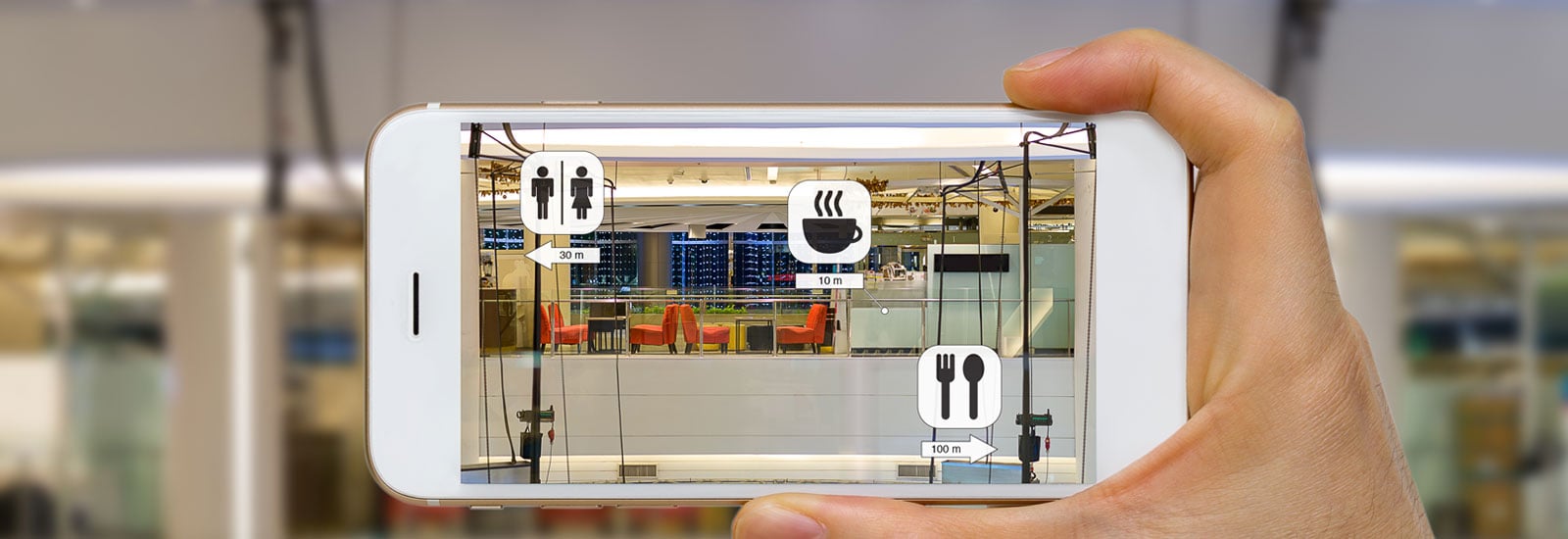What if I told you that you will spend an average of 70% of your lifetime indoors? Would it surprise you? If you have a desk job and live in a city, that number can go up to 90%, not including the time you spend in your car to and from places.

These numbers highlight just how important the role of the built environment to foster psychological wellbeing is. The relationship between interior architecture and wellbeing is wrapped up in design and our behaviours. The thing is, our behaviour is rapidly changing due to technology. We are increasingly dependent on tech to give us information, to guide us, entertain us, give us a feeling of safety, and maybe even comfort. So how do we integrate our built environment and technology?
To answer, we turn our attention to a technology that is very familiar to us, Global Positioning System (GPS). GPS has provided accurate positioning and routes in our everyday lives and built upon features have made its application endless. Now, indoor positioning is emerging as a new technology, with many possibilities and some considerations.
Possibilities
Understand your customers’ behaviour
Through indoor positioning and navigation, you can understand how your customers move within a space, which routes they prefer, where they stand and gather, or what areas of your space is left unutilised.
Enables flexibility
We know that buildings are not fixed spaces, you might merge two rooms into one, or make an area inaccessible due to remodelling. Your space needs to be as flexible as you, and with indoor navigation that is not a problem. Users won’t be lost or frustrated with a lack of signage or changing floor plans when they can rely on indoor wayfinding and positioning to tell them exactly where they are and how to get to where they need to go.

Allows for more intricate architecture
Architects know that it can be complicated to find your way in big buildings. So, in places like airports, they purposefully simplify the space and make it as straightforward as possible. While this is effective for wayfinding, it creates other kinds of human-to-space problems, including management, safety, and stress. Indoor navigation gives more freedom to create built environments that play with private and public spaces, functionality, and flexibility. Though it is a long way off (habits die hard), the future airport, mall, or convention centre could look completely different from what we know now.
Make better buildings
This goes hand in hand with point number 1 and 3, but the data collected through indoor navigation does not only give businesses a better understanding of customer behaviour, it also gives architects a better understanding of human behaviour as a whole. As a result, what used to be intuitive design can now be backed up by tested and observed data.

Lean into the experience economy
We are no longer in the age of industry or service, instead, the economy is now built on experiences, and indoor navigation is a big part of it. No matter the industry, the competition is fierce, and businesses need to create venues that customers keep wanting to come back to. Venues that combine experience and entertainment. With indoor navigation this is possible. Show customers your points of interest and arouse their interest with interactive tours even before they step in your venue.
Considerations
Privacy
If you heard alarm bells every time I mentioned data in the context of indoor navigation, I wouldn’t hold it against you. Like most technology related to the internet of things, indoor positioning uses and can collect user data which can, in turn, be analysed and stored to create profiles. This can lead to some questions about privacy, however, similarly to the advantages we get from GPS with google maps, geolocalisation allows a more personalised experience. Users’ data is protected by being anonymous and is not shared with anyone but the owner of the indoor navigation solution.

A change in skills
This risk is a little more subtle, but it has been debated that depending on technology for wayfinding can lead to an incapacity to acquire environmental knowledge. Mankind has been dependent on these skills for centuries, however, and there is no way of knowing how the use of technology will contribute to the development of our spatial awareness.
Indoor Navigation becoming a part of our daily life is inevitable. It is not only the prolongation of what we have grown accustomed to with outdoor navigation but a platform from which many other services can spring forth. Given this, we are only seeing the tip of the iceberg when it comes to the possibilities indoor navigation opens up.
So if your business has anything to do with being indoors, I encourage you to think of how indoor navigation could help you to be one step ahead into the future.
If you would like more information on how indoor navigation can work for you, check out our industry solutions or dive into one of our free indoor navigation eBooks.
May 24, 2019





.png)